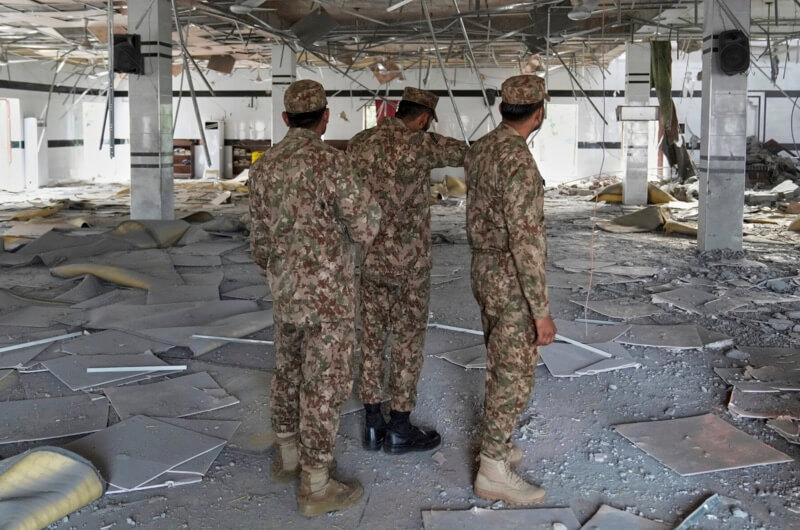By Fakeha Laique
Recently, India’s warmongering has shaken South Asia, paving the way to the possibility of a catastrophic war with Pakistan, underscoring the critical need for sustained diplomatic efforts to break the current cycle of violence.

After the bloody attack on April 22 in Pahalgam, in the occupied Indian region of Jammu and Kashmir (IIOJ&K), which claimed 26 lives, a violent military crackdown broke out and quickly intensified.
On May 7, India launched Operation Sindoor, targeting alleged terrorist militant camps, in Pakistan and Pakistan-administered Kashmir, although Pakistani authorities asserted that these were civilian installations, causing many civilian casualties.
Three days later, India conducted further airstrikes against major military sites in Pakistan, which responded with the “Operation Bunyān al-Marsūs”, hitting Indian military bases. This rapid exchange of retaliatory strikes, involving missile attacks on airfields and air combat, drove the two nuclear-armed neighbours alarmingly close to a full-scale war.
This region is well accustomed to the pattern of rising tensions, political posturing, and eventual peace negotiations. Since becoming independent countries, India and Pakistan have been on the brink of war and have fought three wars. Notably, two of them took place around Kashmir, the bone of contention of this conflict, too. The examples from history: the 1999 Kargil conflict, the 2001-2002 showdown, and the 2019 Pulwama-Balakot crisis demonstrate how similar incidents were underplayed with equal fervour by both sides.
Repeatedly, the world has witnessed how quickly tensions between these countries can develop, especially given their nuclear capabilities. This risk of misjudgement or accidental escalation remains, and experts warn us that more provocative actions may lead to disastrous consequences.
Military operations, such as “Operation Sindoor,” which are used to strengthen the domestic political narrative or show resolve, continued to fail to address the root causes of the conflict. Such actions are often accompanied by higher casualties, destruction of infrastructure, and greater hatred, but seldom effective results. Also, the normalization of cross-border strikes and air operations has made the escalation of conflict more probable, which increases the likelihood of large-scale war, a more plausible outcome that neither country desires.
India’s response to the deadly attack of the 22 April, by suspending key bilateral agreements such as the Indus Waters Treaty (IWT), revoking visa-free travel, and closing trade and borders, has fuelled tensions, requiring Pakistan to retaliate, considering water-flow disruptions as acts of war. These actions only exacerbate the damage and effectively shut down any hope for meaningful diplomatic solutions.
On May 10, 2025, intensive mediation by the United States, under Saudi Arabia and Turkey’s support, led to India and Pakistan agreeing to a total and immediate ceasefire that came into effect at 4:30 p.m. PKT. This ceasefire brought back peace, but soon after, both countries accused each other of violations.
This emphasizes that a ceasefire isn’t the end; rather, it should be a major point that initiates serious and continuous debates. The two countries need to adopt confidence-building measures, such as reviving the 2003 ceasefire accord, supporting diplomatic contact through high commissions, resurrecting the Director General of Military Operations (DGMO) hotline, and promoting cultural and grassroots exchanges to restore trust between each other. A multidimensional approach to dialogue is necessary for dealing with the multi-dimensional issues to eliminate tensions and promote stability across the region.
The diplomatic gap between India and Pakistan affects not only their mutual relations. Intensified tensions undermine economic growth, destabilize regional partnerships, as well as pose enormous security problems owing to the nuclear capabilities of the two countries. The recent incident indicates that although military strength works well and serves as a deterrent, it is diplomacy that diffuses crises and establishes long-term peace. The international community has a considerable part to play in promoting diplomatic action that stops future conflicts.
April and May 2025 saw developments that sharply define the fragile status of peace in South Asia. Although missiles have stopped, core issues persist to plague the peace. Both countries are at a crossroads: either perpetuate the cycle of violence that has its enormous human and economic sacrifices, or invest in a long-term diplomatic initiative to address the bases for the conflict.
The choice is clear. Long-term peace in South Asia needs negotiation, national understanding, and synergistic efforts. It is only possible through mature acts of both countries that the entire region could find lasting peace. International mediation has allowed a ceasefire that will be a critical opportunity for both nations to regain trust and go on to have a future defined not by recurring crises but by stability and partnership.
Now is a defining moment, and with the eyes of the world upon them, India and Pakistan both have the opportunity, indeed the burden, to rely on diplomacy, not conflict, to provide a stable South Asia. The missiles have ceased; now, let the conversations commence.
Author: Fakeha Laique – International Relations graduate from BUITEMS, currently working as a research intern at Balochistan Think Tank Network (BTTN), Quetta, Pakistan.
(The views expressed in this article belong only to the author and do not necessarily reflect the editorial policy or views of World Geostrategic Insights).
Image Credit: AP







